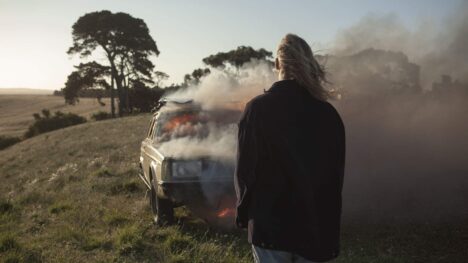Over 30 years, Joy Cowley has become one of New Zealand’s most prolific and successful writers of children’s books, with more than 600 titles for all ages. Christine Miles reveals how her success came about.
In June 2005, Joy Cowley was made a Distinguished Companion of the NZ Order of Merit (DCNZM) for services to children’s literature. Her writer friends jokingly, yet with respect, now refer to her as Dame Joy.
Joy Cowley was born Cassia Joy Summers in a house on a poultry farm in Levin, NZ, in 1936. Joy’s parents, who were both ill, were unable to work, and so she, as the oldest of five children, took responsibility for her younger siblings. “We were raised in an environment of financial poverty,” says Joy, but “life was rich with family experiences.” Even as a child, Joy loved to tell stories, draw pictures and create things.
Ironically, she struggled to learn the alphabet. She remembers her first years at school. “I had no understanding of phonics,” she says. “The teacher tried to beat it into me. It didn’t make sense. The more she hit me, the less I could reason through the process.” Finally her sister told their parents of Joy’s treatment at school, and she was transferred to another. There, at the age of nine, Joy discovered that books equals stories; she “forgot” she couldn’t read, and was hooked.
Writing stories became a passion in her teen years. From age 11 she had stories, rhymes and drawings published in the children’s page of the Southern Cross newspaper. When she was 16, she got an after-school job editing the children’s page of the Manawatu Daily Times, in Palmerston North.
Joy’s chosen career would have been in art or journalism, but her parents apprenticed her to the local pharmacist when she left school. At the age of 20, she married Ted Cowley, lived on a dairy farm and had four children in quick succession.
“In those years,” says Joy, “I milked cows, changed nappies, made puppets and play dough—and wrote short stories in the evenings.”
One was reprinted in Short Story International. “It was read by Doubleday’s New York editor Anne Hutchens, who wrote to ask if I had a novel,” she recalls.
That query led to five novels published by Doubleday between 1967 and 1978. Her first, The Silent One, was made into a film.
“While this was going on, I was also writing stories for my son, Edward, who was a slow reader,” she says. “These little stories extended to other children, other schools and by the early 1970s, teachers were making ‘big books’ from them to use with their students. ‘Can you get these stories published?’ they would ask me.”
Thus, in 1978 Joy began a five-year leave from adult fiction to write a children’s reading program. She became very involved in early childhood reading, and the five years eventually extended to 20, although in 1999 she had her sixth adult novel published.
“There was much life experience in those years,” Joy says. She went through divorce, eventually marrying Terry Coles in 1989. They lived in a menagerie in Marlborough Sound of the South Island of New Zealand until mid-2004.
Joy says she’s constantly thinking about new ideas for her stories, which sometimes leads to trouble.
“My husband Terry was watering vegetables, which grow in a big, animal-proof shade house. I went in to pick a bowl of tomatoes. When I went out, I absent-mindedly bolted the door behind me.”
“An hour later, I thought, Terry is taking a long time to water that garden. As I went out to see if he was all right, I heard a voice calling, ‘Joy! You’ve locked me in!’ Poor Terry! He’s such a nice man that he wasn’t angry—just cold, and tired of shouting. So, you see, stories can put your mind in one place and your actions in another!“
“Once, when I was working on a Mrs Wishy-Washy book, I unpacked the shopping and put the toilet tissue in the freezer!”
Joy has experienced hard times, but with a philosophy of life based on alchemy—turning dross into gold—she turns bad into good.
She explains:
“When I was young, I didn’t understand the biblical proverb, ‘The Lord loveth whom He chasteneth,’ but at the other end of life, I understand better pain’s purpose. It seems the more difficult our experiences, the greater the potential for transformation. In fact, whenever I meet someone who has abundant wisdom and compassion, I know that person has suffered.”
“It was the message Jesus taught over and over and then demonstrated: there are no resurrections without crucifixions, and what is resurrected is always greater than what has died. That gives an underlying sense of peace and rightness—the knowledge that life school is meant to be hard work.“
“If you can recognise you can work through a bad time to make it a good time, you’ve learned something,” she concludes.
Joy’s Inspiration
From where does Joy get her ideas?
“I usually know the answer,” Joy says, “but with the first Mrs Wishy-Washy book, the ideas seem to come from nowhere. It was a cold day, and I had filled the bathtub with hot water, scented bubbles—and me! As I was lying there, swishing the water about, I thought, Wishy-washy, wishy-washy. At once, a scrubbing lady and some animals jumped into my head, and there was my complete story! I didn’t even have to think! I was so excited, I jumped out of the bath, put on a robe and rushed out to the kitchen to write it down.”
“But I should know that most good stories don’t come out of ‘nowhere.’ Rather, they come out of experience—our own or something we’ve seen or heard. It was years before I connected Mrs Wishy-Washy with my own childhood.”
“When I was young, we lived in a house that had no power. Every day, my two younger sisters and I had cold water washes. You can be sure they were quick! Once a week, our parents heated a big copper full of water in the yard and then carried the hot water in buckets, to a tin tub set in front of the kitchen stove. My sisters and I had to play outside while our parents had the first bath. When they were finished, we were called in—three little girls in a tin tub, exactly like Mrs Wishy-Washy’s tub.”
“We loved playing in the hot water, but the fun ended the moment our mother came in with a washcloth and bar of soap. How we hated that scrubbing—ears, necks, knees—and, if we yelled, we got the soapy cloth in our mouth!“
“That experience had been in my memory for so long that it had been buried out of sight. It popped up suddenly in the form of a story—and I’d thought it had come from nowhere.”
Joy has received numerous and prestigious awards and accolades for her writing, including a Commemoration Medal (1990), an OBE (1992) for services to children’s literature, the Margaret Mahy Award Lecture (1993), an honourary doctorate from Massey University, and the NZ Women’s Suffrage Centennial Medal. In 1994 she was awarded for the Best TV Drama Script, and went on to become patron of the New Zealand Children’s Book Foundation. By 2002 her standing led to the Children’s Literature Foundation of New Zealand, in conjunction with Scholastic NZ, creating an award in her own name: the Joy Cowley Award.
In June 2005, Joy was made a Distinguished Companion of the NZ Order of Merit (DCNZM) for services to children’s literature.
She’s still writing full-time, divided between adult writing (articles, spiritual reflection material, stories and novels), books for children, and graded-reading materials for schools. However, she says, “Most weeks, the bulk of writing time is spent answering letters from young friends all over the world, a task that I consider to be more play than work.”
And does she intend to retire from writing? “The day I’m no longer with children is the day I stop writing for them, because the energy flow comes from them and goes back to them.”









